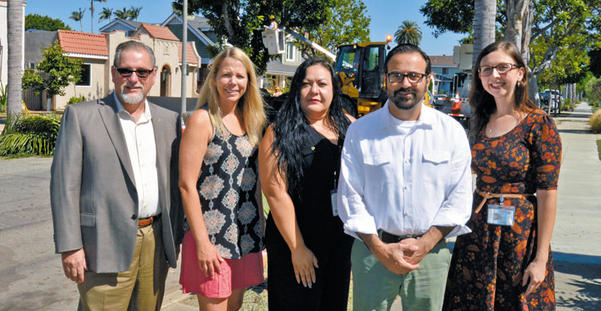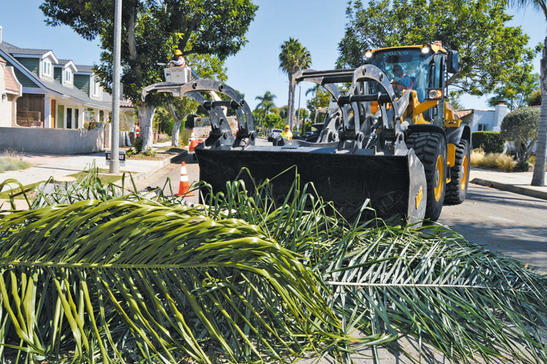As the State of California cracks down on environmental issues – with progressive goals to reduce waste and emissions within a relatively small window – the City of Long Beach continues to stay ahead of mandates with various programs citywide. One such program is the diversion of tree trimmings out of the waste stream.
According to Arthur Cox, public service bureau manager, Long Beach has 92,000 street trees (those lining streets between sidewalks and gutters) that require constant attention.

The City of Long Beach has 92,000 sidewalk trees, according to Arthur Cox, public service bureau manager. He said between his department and hired contractors, 25,000 trees are trimmed and 1,000 are removed annually. Pictured from left: Cox; Erin Rowland, Long Beach Environmental Services Bureau (ESB) waste diversion/recycling officer; Elisa Calderon, ESB recycling specialist; Diko Melkonian, ESB manager; and Leigh Behrens, ESB recycling specialist. (Photograph by the Business Journal’s Larry Duncan)
“Annually, we trim about 25,000 trees and remove around 1,000,” Cox said. “This year is a little higher because of the winter storms. We had one event that had 300 trees that failed that had to be removed.”
Whether done by city employees or contractors, Cox said all tree-trimming green waste is diverted out of the waste stream for other uses. In the case of palm tree debris and broadleaf trees, all waste gets picked up by contractors to be processed in a tub grinder and used in landfills as alternative daily cover – a layer of material that covers trash – in lieu of dirt.
For trees more suitable for wood chipping, they are typically broken down by contractors and used in vacant parking lots, community gardens and paths as a form of weed control. Cox noted that this material is a little bulky to be used as a soil amendment. He added that in the future, he would like to see the program progress to converting wood to fuel pellets.
The city is divided into 32 grids, and the goal is to trim each tree every fifth year, according to Cox. However, palm trees are an “out-of-cycle” tree, needing more attention due to how quickly they grow. Additionally, the city also conducts emergency tree trimming and removals when a supporting limb or entire tree becomes a safety hazard to the community.
The area in which crews work is sometimes dependent on the personnel working on a particular day. Cox explained that some trimmers specialize in canopy or broadleaf trees, while others specialize in palm trees or large removals.
Through tree trimmings and removals, Cox said about 6,700 tons of green waste is produced annually, split evenly between the city and contractors.
“The city is really striving to figure out ways to manage our waste more effectively and find the best use for the material,” Erin Rowland, Long Beach Environmental Service Bureau’s (ESB) newest waste diversion/recycling officer, said. “The example of the city collecting all the tree trimmings and lawn clippings in our public spaces is one of the best things we can do, also looking to identify if there are future opportunities for future residential programs as well.”
According to Diko Melkonian, ESB manager, green waste composes about 10% of waste generated in the state, making it a significant contributor to the waste stream that needs to be managed. Melkonian explained that lawn clippings at Long Beach parks are not bagged but left to become nutrients for grass. Also, tree trimmings at city parks and golf courses are turned into mulch. These practices divert another 10,000 to 15,000 tons of green waste from waste streams annually.

Between Long Beach’s street tree trimming and removal activities, the city generates about 6,700 tons of green waste annually, according to Arthur Cox, public service bureau manager. (Photograph by the Business Journal’s Larry Duncan)
“Residential green waste does get mixed with your typical trash and goes to our waste energy facility where it goes through an incineration process that generates enough power to power 30,000 to 40,000 homes a year,” Melkonian said. “Then the resulting ash . . . can get mixed with concrete to be used as a road base or it can be used as alternative daily cover.”
Nine years ago, the City of Long Beach had a study conducted to determine if a residential green waste program would be appropriate. At the time, Melkonian said the study indicated the city’s carbon footprint was much smaller with its current system. However, he noted that the city is gearing up to recommission another study to identify if there are new opportunities available or if the current system is working.
Leigh Behrens, a recycling specialist with the ESB, said residents already can participate in green waste diversion in multiple ways. Homeowners can take advantage of the water department’s Lawn-to-Garden program and receive rebates for converting grass lawns to drought-tolerant landscaping, which reduces grass clippings and yard waste. The city also presents free composting workshops, which teach people to turn their green waste into compost to be used as soil improvement in home gardens.
State laws, such as AB 1826, are holding certain businesses responsible for organic waste such as food. Businesses will soon be required to arrange for green waste recycling through local trash haulers.
“It’s important to us as a city that if we’re going to talk the talk when it comes to going green and being sustainable, we feel that it is also important to walk the walk,” Behrens said. “Our residents do an amazing job at diverting waste. We are well below the state-mandated waste goal right now. We’re just always looking to expand and go toward a zero-waste goal.”
